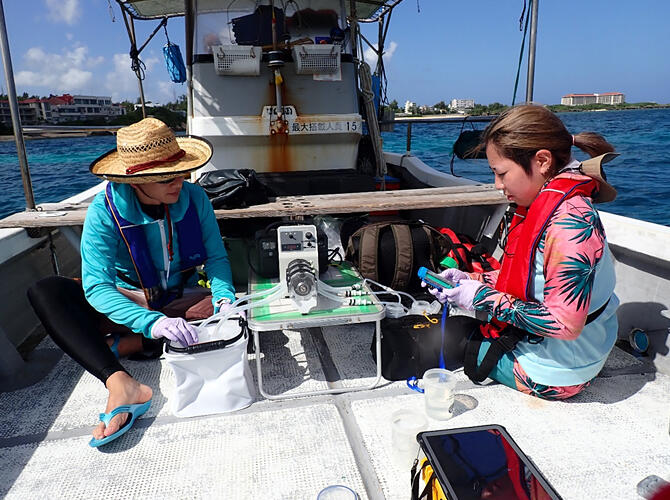Professor Noriyuki Satoh of the Marine Genomics Unit at the Okinawa Institute of Science and Technology (OIST), Tomofumi Nagata of the Incorporated Foundation Okinawa Prefecture Environment Science Center and a research group from the University of Tokyo have jointly announced that extracting and analyzing environmental DNA (eDNA) from surface seawater can be used to identify reef‐building coral living at a survey site. Analysis of eDNA and direct observations by divers were conducted simultaneously in the sea of Okinawa, and the results of both methods matched with a high level of accuracy. It is expected that the eDNA analysis method has the potential to be able to identify the genera of reef‐building corals both on a large scale and comprehensively, without diving into the ocean. The results have been published in the international journal Proceedings of the Royal Society B: Biological Sciences.

Provided by OIST
Although coral reefs cover only about 0.2% of the entire ocean, they are home to approximately 30% of all marine life and are considered important for maintaining marine biodiversity. Coral reefs, which are composed mainly of reef‐building corals, have been facing the threat of extinction in recent years due to bleaching caused by global warming. There are approximately 1,300 species of reef‐building corals among 236 genera worldwide.
In taxonomic and ecological surveys of reef‐building corals, experts use scuba diving and other means to directly observe, classify and record the corals. However, these surveys are dangerous for the divers, and even experts have difficulty detecting rare and small species. Therefore, there has been a need to develop techniques and methods that can provide a broader and more comprehensive understanding of the actual state of coral species.
In 2011, a research group from OIST and the University of Tokyo succeeded in developing primers that amplified only the eDNA of reef‐building corals. These primers can be used to detect 45 genera of reef‐building corals and the research group used them to confirm the applicability of the 'coral eDNA analysis method' in water tank experiments.
In the present study, the research group verified the applicability of this method to large‐scale surveys in the ocean around Okinawa. The research group from OIST collected surface seawater samples (2‐3 samples of 2 liters each) by boat for eDNA analysis. At the same time, two divers from the Incorporated Foundation Okinawa Prefecture Environment Science Center conducted a survey of coral reefs at sites under the Monitoring Sites 1000 project run by the Ministry of the Environment of Japan. The survey was conducted from early September to late December 2021 at 63 sites all around the main island of Okinawa. Most of the sites were located on reef slopes at depths of 3‐10 meters, including lagoons at depths of 3‐5 meters. The visual surveys revealed two to four dominant genera.
Seawater samples collected on the boat were filtered, then the eDNA attached to the filter was fixed and returned to the laboratory for analysis. As a result, eDNA samples of reef‐building corals were obtained from 62 sites (one site was not sampled because of unfavorable weather conditions). Compared with the visual survey results, the eDNA results were well matched with visual results at 41 of the 62 sites (67%). Fifteen sites were moderately matched with a least two genera detected (24%), four sites detected at least one genus and were a partial match (6%), and two sites had no matches (3%). The eDNA results supported the visual survey results with 91% accuracy. eDNA analysis of surface seawater from the coral reefs indicated the possibility of identifying the underlying coral genera.
The coral genera could be identified with a high degree of accuracy, with different results obtained at adjacent sites, even when taking the presence of tidal currents around Okinawa Island into account. Corals secrete a large amount of mucus, which is lighter than water and floats on the seawater surface. The inclusion of this mucus in the sample may have contributed to the high accuracy of identification. Additionally, the eDNA analysis detected the genus Heliofungia, which has not been reported from Okinawa Island and had been thought to have its northern limit on Miyako Island; this is a target for future study.
Satoh commented on the results, "At present, there are 45 genera of reef‐building corals for which information on their mitochondrial genomes is available. If we can increase the number of genera that can be studied, we believe that we will be able to clarify the actual status of many more. Using NTT DOCOMO's advanced underwater drone technology, we have also begun a joint survey of seawater at depths of 20 to 100 meters, where humans cannot dive. Since corals symbiotically photosynthesize with zooxanthellae, they do not exist in areas where light cannot reach. However, they are known to exist at depths of up to 80 meters in Zamami. We hope to be able to study coral reefs around the world using this newly developed method, not only because it can be done without diving, but also because it can be used in small island nations where funding for diving and other research is not always available."
This article has been translated by JST with permission from The Science News Ltd. (https://sci-news.co.jp/). Unauthorized reproduction of the article and photographs is prohibited.




